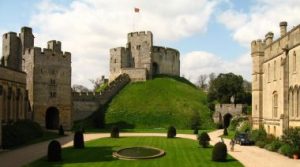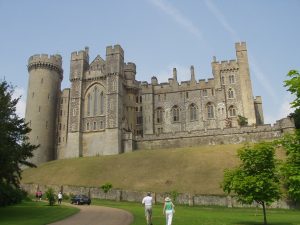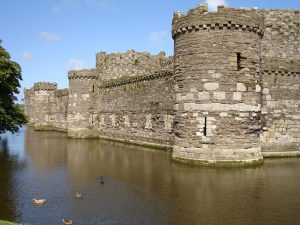Medieval castles were designed to be both defensive structures and residences of noblemen. From the very first earthwork enclosures built by the Normans to the more sophisticated Late Middle Ages Castles, they rapidly evolved and soon became a symbol of the nobility’s social status.

Image source: https://commons.wikimedia.org/wiki/File:Old_Sarum_Castle_reconstruction.png
Medieval castles were built from the 11th century CE for rulers to demonstrate their wealth and power to the local population, to provide a place of defense and safe refuge in the event of an attack, to defend strategically important sites such as river fords, passes through hills, mountains and borders, and as a place of residence. Castles were converted from wood to stone and became increasingly impressive structures with increasingly defensive features such as round towers and fortified gates.
Where were castles built?
A good location for a castle was on a natural rise, near a cliff, on the bend of a river, or where older fortifications such as Roman walls could be reused. Castles needed their water and food and a permanent defensive strength, factors to consider when choosing a location.

Image source: https://search.creativecommons.org/photos/80024f8f-a325-494c-b43a-84fe2ea29c5b Author:by kojotomoto
Castles were an expensive undertaking that could take years to complete. A master builder led a team of hundreds of skilled workers including carpenters, blacksmiths, dam specialists, and common laborers. Transporting the materials was very expensive so the proximity of a local quarry was a great advantage.
Main castles features
The typical characteristics of a medieval castle were:
- Moat – a perimeter ditch with or without water;
- Barbican – a fortification to protect a gate;
- Curtain Walls & Towers – the perimeter defensive wall;
- Fortified Gatehouse – the main entrance to the castle;
- Keep (also known as Donjon or Great Tower) – the largest tower and the best stronghold in the castle;
- Bailey or Inner Ward (courtyard) – the area within a curtain wall.
Within an Existing Roman Fortress

Image source: https://search.creativecommons.org/photos/d3dceef2-2f7d-4559-9819-8f1c580b9fd2 Author:by TheJRB
The first medieval castles built by the Normans were built within an existing Roman Fort or were Motte and Bailey castles. These were soon replaced by Stone Keep castles which offered better protection. Concentric castles developed during the 12th and 13th Centuries and were impossible to conquer. Pevensey Castle in East Sussex is an example of a Norman Castle built inside a pre-existing Roman Fort.
Motte and Bailey Castles

Image source: https://commons.wikimedia.org/
The first form of medieval castles built completely from scratch by the Normans were the castles of Motte and Bailey divided into two parts. The Motte was a large hill of earth on which a wooden lookout was built, and the outer edge was surrounded by a large wooden fence called a palisade. The Bailey was separated from the Motte by a removable wooden bridge to face a possible enemy invasion. The Bailey was the part of the castle dedicated to people and animals. For further protection of the castle, both the Motte and the Bailey were surrounded by a moat, often filled with water which had to be accessed via a drawbridge.
Stone Keep Castle

Image source: https://search.creativecommons.org/photos/3c2e4cfb-84bc-4a66-b3dd-03e240ab26f4 Author:by Steven Penton
This type of medieval castle replaced the Motte and Bailey castles as it offered a better form of defense. A stone keep was the central element, with thick walls and few windows. The entrance to the keep was via stone steps that led to the first floor. The kitchens were located on the ground floor while the apartments were on the upper floors. The first towers were rectangular but the later ones were often circular. The Stone Keep was surrounded by a thick stone wall containing lookout towers. The Bailey was now the area outside the keep.
Concentric Castles

Image source: https://search.creativecommons.org/photos/65b56d41-2ab0-44c3-81dc-2908a231221a Author: by lyng883
In the 12th and 13th Centuries, the Concentric castle was developed that can offer better protection against attacks. Its main feature was its walls. A thick stone interior wall with turrets positioned at intervals is then surrounded by an equally thick but lower stone wall. The walls are built at different levels in order to allow archers on the inside walls to shoot archers on the outer walls. The space between the two walls was known as the ‘death hole’ because being trapped in it would surely have resulted in the attacker’s death. The entire castle was often surrounded by a moat and was accessed via a drawbridge.
Info sources: https://www.ancient.eu/Medieval_Castle/ https://en.wikipedia.org/wiki/Castle https://www.historyonthenet.com/medieval-castle https://www.english-heritage.org.uk/learn/histories/medieval-castles/
